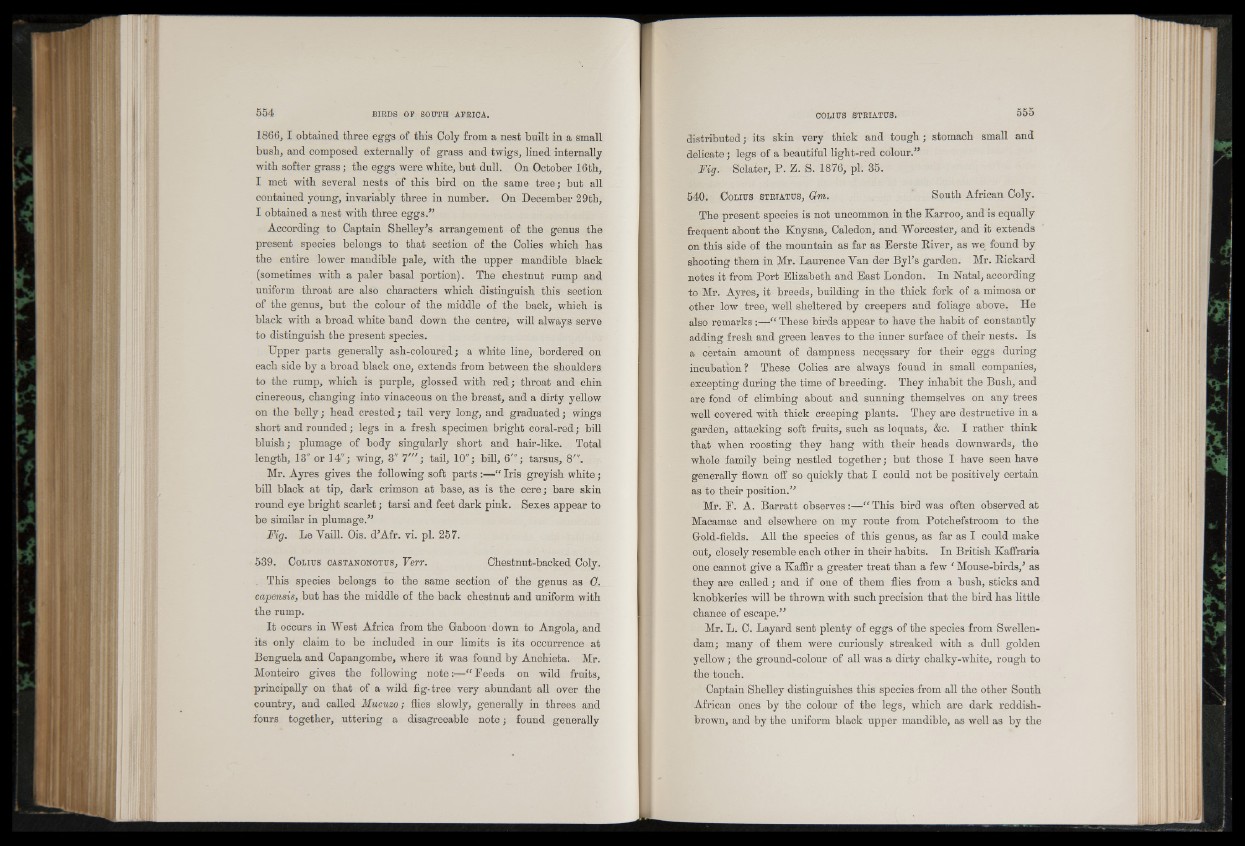
1866, 1 obtained three eggs of this Coly from a nest built in a small
bush, and composed externally of grass and twigs, lined internally
with softer grass; the eggs were white, but dull. On October 16th,
I met with several nests of this bird on the same tree; but all
contained young, invariably three in number. On December 29 th,
I obtained a nest with three eggs."
According to Captain Shelley’s arrangement of the genus the
present species belongs to that section of the Colies which has
the entire lower mandible pale, with the upper mandible black
(sometimes with a paler basal portion). The chestnut rump and
uniform throat are also characters which distinguish this section
of the genus, but the colour of the middle of the back, which is
black with a broad white band down the centre, will always serve
to distinguish the present species.
Upper parts generally ash-coloured; a white line, bordered on
each side by a broad black one, extends from between the shoulders
to the rump, which is purple, glossed with red; throat and chin
cinereous, changing into vinaceous on the breast, and a dirty yellow
on the belly; head crested; tail very long, and graduated; wings
short and rounded; legs in a fresh specimen bright coral-red; bill
bluish; plumage of body singularly short and hair-like. Total
length, 13" or 14"; wing, 3" 7'"; tail, 10"; bill, 6"'; tarsus, 8"'.
Mr. Ayres gives the following soft parts :—“ Iris greyish white;
bill black at tip, dark crimson at base, as is the cere; bare skin
round eye bright scarlet; tarsi and feet dark pink. Sexes appear to
be similar in plumage."
Fig. Le Yaill. Ois. d’Afr. vi. pi. 257.
539. C olius castanonotus, Yerr. Chestnut-backed Coly.
. This species belongs to the same section of the gpnus as G.
capensis, but has the middle of the back chestnut and uniform with
the rump.
It occurs in West Africa from the Gaboon down to Angola, and
its only claim to be included in our limits is its occurrence at
Benguela and Capangombe, where it was found by Anchieta. Mr.
Monteiro gives the following note:—“ Feeds on wild fruits,
principally on that of a wild fig-tree very abundant all over the
country, and called Mucuzo; flies slowly, generally in threes and
fours together, uttering a disagreeable note; found generally
distributed; its skin very thick and tough; stomach small and
delicate; legs of a beautiful light-red colour."
Fig. Sclater, P. Z. S. 1876, pi. 35.
540. C olius strtatus, Gm. South African Coly.
The present species is not uncommon in the Karroo, and is equally
frequent about the Knysna, Caledon, and Worcester, and it extends
on this side of the mountain as far as Eerste River, as we found by
shooting them in Mr. Laurence Yan der Byl’s garden. Mr. Rickard
notes it from Port Elizabeth and East London. In Natal, according
to Mr. Ayres, it breeds, building in the thick fork of a mimosa or
other low tree, well sheltered by creepers and foliage above. He
also remarks :—“ These birds appear to have the habit of constantly
adding fresh and green leaves to the inner surface of their nests. Is
a certain amount of dampness necessary for their eggs during
incubation ? These Colies are always found in small companies,
excepting during the time of breeding. They inhabit the Bash, and
are fond of climbing about and sunning themselves on any trees
well covered with thick creeping plants. They are destructive in a
garden, attacking soft fruits, such as loquats, &c. I rather think
that when roosting they hang with their heads downwards, the
whole family being nestled together; but those I have seen have
generally flown off so quickly that I could not be positively certain
as to their position."
Mr. F. A. Barratt observes:—“ This bird was often observed at
Macamac and elsewhere on my route from Potchefstroom to the
Gold-fields. All the species of this genus, as far as I could make
out, closely resemble each other in their habits. In British Kaffraria
one cannot give a Kaffir a greater treat than a few ‘ Mouse-birds/ as
they are called; and if one of them flies from a bush, sticks and
knobkeries will be thrown with such precision that the bird has little
chance of escape."
Mr. L. C. Layard sent plenty of eggs of the species from Swellen-
dam; many of them were curiously streaked with a dull golden
yellow; the ground-colour of all was a dirty chalky-white, rough to
the touch.
Captain Shelley distinguishes this species from all the other South
African ones by the colour of the legs, which are dark reddish-
brown, and by the uniform black upper mandible, as well as by the